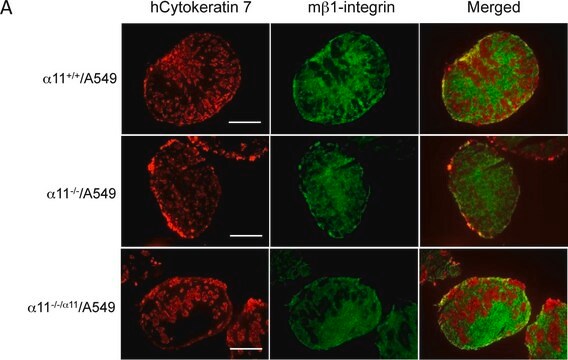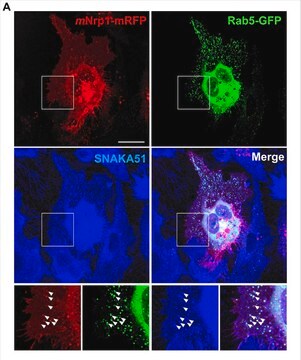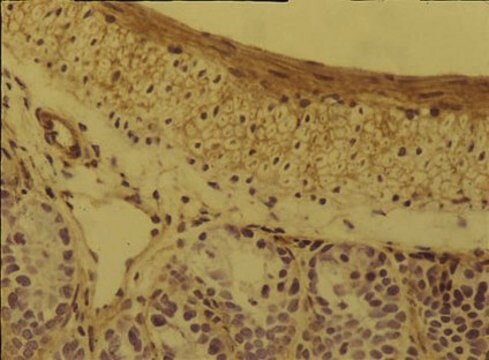AB1928
Anti-Integrin α5 Antibody, CT, Intracellular
serum, Chemicon®
Sinonimo/i:
CD49e, Fibronectin Receptor alpha Subunit
About This Item
Prodotti consigliati
Origine biologica
rabbit
Livello qualitativo
Forma dell’anticorpo
serum
Tipo di anticorpo
primary antibodies
Clone
polyclonal
Reattività contro le specie
human, chicken, hamster, rat, mouse
Produttore/marchio commerciale
Chemicon®
tecniche
ELISA: suitable
immunocytochemistry: suitable
immunofluorescence: suitable
immunohistochemistry: suitable
immunoprecipitation (IP): suitable
radioimmunoassay: suitable
western blot: suitable
N° accesso NCBI
N° accesso UniProt
Condizioni di spedizione
dry ice
modifica post-traduzionali bersaglio
unmodified
Informazioni sul gene
human ... ITGA5(3678)
Descrizione generale
Specificità
Immunogeno
Applicazioni
1:1000 dilution of a previous lot was used.
ELISA:
1:500-1:2000 dilution of a previous lot was used in ELISA.
Immunoprecipitation:
Recommended use of 5 μL of antibody for 5x106 cells.
Immunohistochemistry:
1:1000 dilution of a previous lot was used in tissue staining; suggested for use on acetone fixed tissue only.
Immunocytochemistry:
1:1000 of a previous lot was used in immunocytochemistry.
Optimal working dilutions must be determined by the end user.
Qualità
Western Blot Analysis: 1:1000 dilution of this lot detected integrin alpha 5 on 10 μg of HUVEC lysates.
Descrizione del bersaglio
Stato fisico
Risultati analitici
Mouse 3T3 fibroblasts Skin (Basement Membrane).
Altre note
Note legali
Non trovi il prodotto giusto?
Prova il nostro Motore di ricerca dei prodotti.
Raccomandato
Codice della classe di stoccaggio
12 - Non Combustible Liquids
Classe di pericolosità dell'acqua (WGK)
WGK 1
Punto d’infiammabilità (°F)
Not applicable
Punto d’infiammabilità (°C)
Not applicable
Certificati d'analisi (COA)
Cerca il Certificati d'analisi (COA) digitando il numero di lotto/batch corrispondente. I numeri di lotto o di batch sono stampati sull'etichetta dei prodotti dopo la parola ‘Lotto’ o ‘Batch’.
Possiedi già questo prodotto?
I documenti relativi ai prodotti acquistati recentemente sono disponibili nell’Archivio dei documenti.
Il team dei nostri ricercatori vanta grande esperienza in tutte le aree della ricerca quali Life Science, scienza dei materiali, sintesi chimica, cromatografia, discipline analitiche, ecc..
Contatta l'Assistenza Tecnica.







